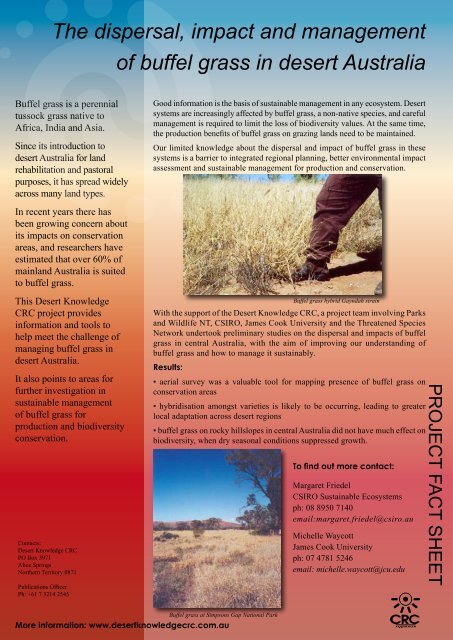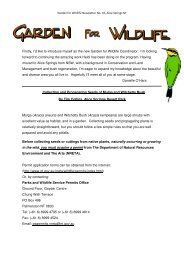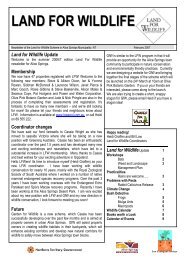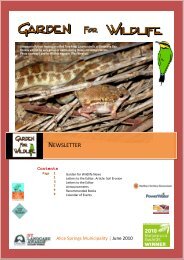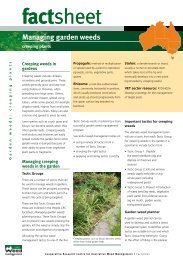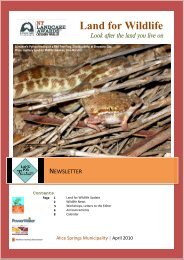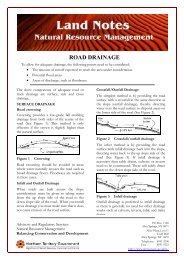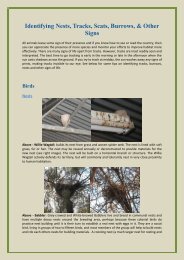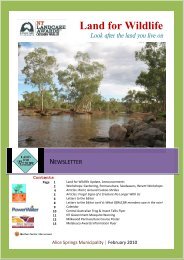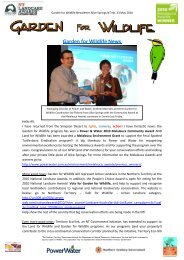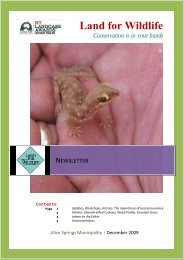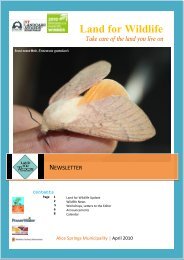DKACRC Buffel Grass Control Factsheet - Land for Wildlife
DKACRC Buffel Grass Control Factsheet - Land for Wildlife
DKACRC Buffel Grass Control Factsheet - Land for Wildlife
You also want an ePaper? Increase the reach of your titles
YUMPU automatically turns print PDFs into web optimized ePapers that Google loves.
The dispersal, impact and management<br />
of buffel grass in desert Australia<br />
<strong>Buffel</strong> grass is a perennial<br />
tussock grass native to<br />
Africa, India and Asia.<br />
Since its introduction to<br />
desert Australia <strong>for</strong> land<br />
rehabilitation and pastoral<br />
purposes, it has spread widely<br />
across many land types.<br />
In recent years there has<br />
been growing concern about<br />
its impacts on conservation<br />
areas, and researchers have<br />
estimated that over 60% of<br />
mainland Australia is suited<br />
to buffel grass.<br />
This Desert Knowledge<br />
CRC project provides<br />
in<strong>for</strong>mation and tools to<br />
help meet the challenge of<br />
managing buffel grass in<br />
desert Australia.<br />
It also points to areas <strong>for</strong><br />
further investigation in<br />
sustainable management<br />
of buffel grass <strong>for</strong><br />
production and biodiversity<br />
conservation.<br />
Contacts:<br />
Desert Knowledge CRC<br />
PO Box 3971<br />
Alice Springs<br />
Northern Territory 0871<br />
Publications Officer<br />
Ph: +61 7 3214 2545<br />
Good in<strong>for</strong>mation is the basis of sustainable management in any ecosystem. Desert<br />
systems are increasingly affected by buffel grass, a non-native species, and careful<br />
management is required to limit the loss of biodiversity values. At the same time,<br />
the production benefits of buffel grass on grazing lands need to be maintained.<br />
Our limited knowledge about the dispersal and impact of buffel grass in these<br />
systems is a barrier to integrated regional planning, better environmental impact<br />
assessment and sustainable management <strong>for</strong> production and conservation.<br />
With the support of the Desert Knowledge CRC, a project team involving Parks<br />
and <strong>Wildlife</strong> NT, CSIRO, James Cook University and the Threatened Species<br />
Network undertook preliminary studies on the dispersal and impacts of buffel<br />
grass in central Australia, with the aim of improving our understanding of<br />
buffel grass and how to manage it sustainably.<br />
Results:<br />
<strong>Buffel</strong> grass hybrid Gayndah strain<br />
• aerial survey was a valuable tool <strong>for</strong> mapping presence of buffel grass on<br />
conservation areas<br />
• hybridisation amongst varieties is likely to be occurring, leading to greater<br />
local adaptation across desert regions<br />
• buffel grass on rocky hillslopes in central Australia did not have much effect on<br />
biodiversity, when dry seasonal conditions suppressed growth.<br />
To find out more contact:<br />
Margaret Friedel<br />
CSIRO Sustainable Ecosystems<br />
ph: 08 8950 7140<br />
email:margaret.friedel@csiro.au<br />
Michelle Waycott<br />
James Cook University<br />
ph: 07 4781 5246<br />
email: michelle.waycott@jcu.edu<br />
PROJECT FACT SHEET<br />
<strong>Buffel</strong> grass at Simpsons Gap National Park<br />
More in<strong>for</strong>mation: www.desertknowledgecrc.com.au
Aerial mapping of buffel grass in<br />
conservation areas: a case study<br />
Aerial survey of Watarrka National Park proved<br />
to be a quick way to collect in<strong>for</strong>mation on<br />
buffel grass cover over a large geographic area,<br />
especially in more remote or rugged areas.<br />
Aerial mapping was less costly than extensive<br />
ground-based surveys and can be repeated to monitor<br />
change over time. <strong>Buffel</strong> grass was more widely<br />
spread than previous records showed, especially <strong>for</strong><br />
the more inaccessible areas of the park, enabling<br />
better targeted control by land managers.<br />
What did we find out about buffel grass<br />
dispersal and population dynamics<br />
We combined the data from the aerial survey<br />
of Watarrka National Park with known<br />
environmental variables to create a model <strong>for</strong><br />
predicting probable buffel grass spread. We<br />
found that the distance to drainage and tracks,<br />
ruggedness, hummock grass cover and soil<br />
texture were the most important variables in<br />
determining the occurrence of buffel grass.<br />
Genetic analysis of samples of buffel grass from apparently different varieties<br />
growing on both Woodgreen Station and Watarrka National Park produced a<br />
surprising result. When we compared 11 common commercial varieties with<br />
these samples, some had a high degree of similarity and some were identical.<br />
However, some samples had affinities to more than one variety, indicating<br />
that hybridisation was occurring.<br />
We propose that new strains better adapted to local conditions are <strong>for</strong>ming<br />
through this hybridisation. New <strong>for</strong>ms may be better adapted to the<br />
environmental conditions but may not be so good <strong>for</strong> pastoral uses. One<br />
consequence may be that selective grazing on pastoral lands will lead to an<br />
increased dominance of unpalatable <strong>for</strong>ms of buffel grass.<br />
Biodiversity impacts of buffel grass in central Australia<br />
At Watarrka National Park at least 28% of rare species had some of their<br />
habitat occupied by buffel grass, and some of the habitats with the highest<br />
plant diversity coincided with the current and predicted occurrence of the grass.<br />
We found that buffel grass occurred in over 90% of the areas where melaleucas<br />
grew, which greatly increases the risk to their habitat from grass fire.<br />
We studied biodiversity impacts in witchetty-mulga shrublands in rocky hillslopes<br />
north of Alice Springs. <strong>Buffel</strong> grass has extensively colonised this habitat in the<br />
last decade. We had very low rainfall during the study period and so we could not<br />
demonstrate that buffel grass had a significant effect on biodiversity.<br />
This does not mean that there is no long term impact, but that the levels of<br />
buffel grass cover were likely to have been too low to show an effect. We<br />
know from other central Australian studies in different habitats and conditions<br />
that buffel grass can indeed impact on ground vegetation and invertebrates.<br />
Future research<br />
We believe that further long-term research is necessary to:<br />
• identify the range of tools <strong>for</strong> managing buffel grass<br />
• focus attention on generally acceptable management actions<br />
• quantify social, environmental and economic benefits and costs<br />
• and develop a framework <strong>for</strong> a national policy on buffel grass.<br />
<strong>Buffel</strong> grass stabilises a ponding bank on Woodgreen Station<br />
Core partners<br />
Central <strong>Land</strong> Council (CLC)<br />
Charles Darwin University<br />
Commonwealth Scientific and Industrial<br />
Research Organisation (CSIRO)<br />
Curtin University of Technology<br />
Desert Peoples Centre<br />
Government of Western Australia<br />
Northern Territory Government<br />
Office of Indigenous Policy<br />
Coordination (OIPC)<br />
Fact sheet: 63<br />
Project: 1.702<br />
Last updated: March 2007<br />
Centre partners<br />
Griffith University<br />
James Cook University<br />
Murdoch University<br />
Newmont Australia<br />
University of South Australia<br />
Associate partners<br />
Department of Primary Industries, NSW<br />
Flinders University<br />
(Centre <strong>for</strong> Remote Health)<br />
South Australian Department of Water,<br />
<strong>Land</strong> and Biodiversity Conservation<br />
Southern Cross University<br />
Tapatjatjaka Community<br />
Government Council<br />
The Australian National University<br />
The University of Adelaide<br />
The University of Queensland<br />
The University of Western Australia<br />
University of Wollongong<br />
Affiliate partners<br />
Australian Institute of Aboriginal and<br />
Torres Strait Islander Studies (AIATSIS)<br />
Indigenous Australian Foods<br />
Robins Foods<br />
Waltja Tjutangku Palyapayi


